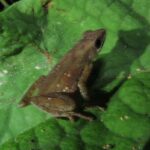- Introduction: A Hidden Jewel Among the Pines and Palms
- Taxonomy and Classification: Unraveling the Scientific Identity
- Natural Habitat: The Subtle Secrets of Mountain Rainforests
- Physical Characteristics: Quiet Beauty and Camouflaged Grace
- Behavior and Life Cycle: Life Amidst Leaves, Shadows, and Dew
- Ecological Role: Quiet Guardians of Forest Health
- Threats and Conservation Status: A Fragile Existence Threatened
- Cultural and Scientific Significance: Illuminating the Unseen Wonders
- Conclusion: Championing the Quiet Ambassadors of Biodiversity
Introduction: A Hidden Jewel Among the Pines and Palms#
Beneath a dense canopy dripping with dew and echoing with the calls of birds, crickets, and countless insects, life bursts forth in countless tiny dramas. Each tree limb, leaf pile, and forest stream harbors astonishing secrets—species often unknown to the casual observer but vital links in the tapestry of biodiversity. Among these cryptic treasures of Brazil’s Atlantic Forest lives a small, elusive creature: Ischnocnema parnaso, a frog whose presence quietly signifies the ecological vitality of some of Earth’s most threatened habitats.
Nimbly camouflaged and intricately adapted to their environment, these tiny amphibians remain largely hidden, underscored by their quiet call and subtle beauty. Named after the majestic Serra dos Órgãos (Parnaso National Park) in southeastern Brazil, Ischnocnema parnaso holds deep—if quiet—importance as a symbol of biodiversity and conservation.
Taxonomy and Classification: Unraveling the Scientific Identity#
To unveil the mysteries surrounding Ischnocnema parnaso, it’s essential to understand its scientific identity. Belonging to the family Brachycephalidae, this unique group of amphibians is notable for its direct-developing frogs, meaning that they skip the aquatic larval stage typical to most frogs and develop directly from egg to miniature froglet.
Ischnocnema parnaso, first described scientifically in 2009, contributes significantly to the genus Ischnocnema, a collection of similarly compact, terrestrial species. Its closest relatives share its subdued coloration and terrestrial life strategy, which serve as critical adaptations for navigating life in leafy terrain, away from the direct gaze of predators.
Natural Habitat: The Subtle Secrets of Mountain Rainforests#
The gentle slopes and humid valleys of southeastern Brazil’s Serra dos Órgãos mountain range are home to Ischnocnema parnaso. This small frog thrives specifically in the lush, montane Atlantic Rainforest—a biodiversity hotspot recognized globally for harboring a staggering diversity of flora and fauna.
Unlike typical frogs that prefer rushing streams or quiet ponds, I. parnaso makes a quiet, subtle home on forest floors, nestled within fallen leaf litter, mossy crevices, and damp vegetation. Comfortable in the twilight beneath towering evergreens and endemic palms, its chosen realm is perpetually humid yet sheltered from direct sunlight. Such conditions provide optimal humidity for its sensitive amphibian skin while also creating perfect hiding spots from vigilant predators.
Microhabitat Preferences#
This quiet frog rarely ventures far from the moist ground. It primarily occupies elevations between 800 and 1500 meters, areas blanketed with dense vegetation, leaf-littered soils, and an extensive system of decomposing foliage and root mats. Precisely because of this microhabitat dependence, alterations caused by deforestation and habitat fragmentation pose genuine threats to its survival.
Physical Characteristics: Quiet Beauty and Camouflaged Grace#
No bigger than a thumbnail, measuring just around 2 cm in length, Ischnocnema parnaso proves that beauty often expresses itself subtly. Resembling small, sturdy jewels nestled in a verdant setting, their coloration ranges from muted browns, greens, to olive hues—colors adapted painstakingly over evolutionary time to blend nearly seamlessly with leaf litter and mossy earth.
Upon closer inspection, layers of subtle visual elegance emerge. Delicate patterns of mottled markings, occasionally punctuated by tiny dashes or spots, further blend this frog effortlessly into its background. Its skin, finely textured, almost granular in appearance, both facilitates moisture retention and enhances camouflage against the textured forest floor.
Adaptations for Survival#
Cloaked invisibility is not merely ornamental; rather, it’s crucial for evading predators like birds, snakes, and invertebrates. Furthermore, coloration and texture adjustments help I. parnaso maintain skin humidity levels precisely necessary for cutaneous respiration—amphibians’ primary respiration method through their delicate skin.
Behavior and Life Cycle: Life Amidst Leaves, Shadows, and Dew#
Observing I. parnaso‘s behavior demands patience. Elusive and primarily nocturnal, it spends daylight hours sheltered beneath leaf debris or nestled within moss carpets, emerging confidently at nightfall in search of prey and mates.
Its diet primarily consists of minute arthropods: tiny springtails, ants, mites, and beetle larvae composing a flavorful menu for such a diminutive predator. Utilizing agile leaps and precise ambush tactics beneath the moist moonlit leaf litter, these frogs play significant roles in regulating the populations of numerous invertebrate species throughout their habitat.
Reproductive Wonders: Direct Development Explained#
Possibly the most fascinating aspect of I. parnaso‘s biology is its method of reproduction. Unlike traditional frogs whose eggs hatch into aquatic tadpoles, these frogs exhibit direct development, an incredible evolutionary adaptation. Females deposit a small clutch of eggs beneath moist leaf litter—protected from predators and environmental stressors—where embryonic froglets directly develop inside the protective eggs before emerging as miniature replicas of their parents, entirely skipping the vulnerable aquatic tadpole stage. This adaptation is particularly nature’s ingenious solution to surviving in terrestrial habitats devoid of consistent aquatic breeding habitats.
Ecological Role: Quiet Guardians of Forest Health#
Though small, Ischnocnema parnaso plays a vital ecological role within its ecosystem. Its insectivorous diet influences insect populations, acting as a natural pest controller and contributing significantly to healthy nutrient and energy cycles within complex Atlantic forest food webs. As prey itself, its population health acts as an invaluable barometer to assess predator health further up the food chain, thereby offering scientists insights into overall ecosystem fitness.
Furthermore, its sensitivity to environmental change renders it a valuable indicator species—highlighting habitat quality or degradation whenever populations begin to fluctuate significantly.
Threats and Conservation Status: A Fragile Existence Threatened#
Sadly, the Atlantic Forest biome faces immense pressure. Human-driven habitat loss caused by agriculture, logging, residential development, and forest fires remains the greatest existential threat to I. parnaso. Additionally, climate-driven shifts in temperature and rainfall patterns further exacerbate stress upon sensitive amphibian populations.
Currently classified as “Data Deficient” by the International Union for Conservation of Nature (IUCN), the true health and numbers for I. parnaso populations remain alarmingly unknown. Thus, targeted research efforts, effective monitoring, and sustained habitat protection initiatives are now critical to maintaining stable populations of this delicate amphibian.
Positive Conservation Initiatives#
Parnaso National Park offers significant refuge, and ongoing conservation initiatives promote habitat restoration and sustainable ecotourism. Local education programs sketched around these small ambassadors of biodiversity actively engage communities in stewardship efforts, raising awareness about the importance of amphibian conservation.
Cultural and Scientific Significance: Illuminating the Unseen Wonders#
Although lacking high-profile recognition among humans, species like Ischnocnema parnaso significantly enhance scientific understanding of biodiversity, evolution, and ecological stability. Timeless ambassadors of global biodiversity hotspots, these frogs spotlight the critical interplay between sustainable ecosystems and larger planetary health.
Culturally, endemic species such as these pridefully symbolize Brazil’s ecological treasures and ongoing conservation efforts aimed at preserving the country’s beloved forest heritage for future generations.
Conclusion: Championing the Quiet Ambassadors of Biodiversity#
Hidden in the leaf litter beneath towering palms and mist-laden canopies, Ischnocnema parnaso quietly thrives, a living reminder of the diverse life sustained within Brazil’s Atlantic Rainforests. To protect these precious ecosystems is to safeguard the quiet wonders dwelling within their shadows.
As stewards of our natural world, it is upon us to explore, appreciate, and advocate for these overlooked yet profoundly important species. In knowing the story of I. parnaso, we join the chorus calling for awareness, conservation efforts, and the preservation of the world’s most fragile yet quintessentially beautiful creatures on our shared planet.







